Announcements
This Friday, March 1 from 3-5 pm at our Winter Twig ID Open House practice winter twig identification skills with a display of common native deciduous trees and shrubs in Lab 1 rm 1050. Bring a 10X hand lens and the Pacific Northwest Winter Twig flashcards available for purchase at The Greener Store. For poster, see Twigology_POSTER_w24
New book on the natural history of Mount Rainier National Park
Naturalist and author Jeff Antonelis-Lapp’s new book Tahoma and Its People on the natural history of Mount Rainier National Park was published last spring by Washington State University Press. The book covers a wide range of topics, including the presence of Native Americans at the mountain for over 9,000 years, and the effects of climate change that extend far beyond the retreating glaciers. Antonelis-Lapp is a retired professor of The Evergreen State College who taught environmental education for many years.
“Blue Carbon: A Story from the Snowhomish Estuary”
The video: “Blue Carbon: A Story from the Snohomish Estuary” features RAE and EarthCorps staff, volunteers and local partners telling the story of blue carbon, from the Snohomish Estuary in Puget Sound, Washington.
The video has been uploaded to EarthCorps’s YouTube Channel and RAE’s Blue Carbon Homepage and can be viewed above. I encourage you to share the video on your social media platforms (#bluecarbon) and make use of the video as a resource for increasing awareness of blue carbon and the importance of estuary restoration.
Funding was provided by the Laird Norton Family Foundation and Wildlife Forever Fund. Videography by Benjamin Drummond and Sara Steele.
Winter Quarter; Places to go in Washington: Palouse Falls State Park
by: Sam Mejia
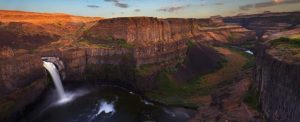
Palouse Falls, located in southeast Washington State, flows through a narrow cataract and drops 200 feet into a churning bowl. The current moves through the Palouse River Canyon, cutting into the Columbia River basalt between the Snake River and Washtucna Coulee. The landscape of Palouse Falls state Park is typically made of shrub-steppe and basalt cliff vegetation.
Named Washington’s state waterfall in 2014, Palouse Falls was carved more than 13,000 years ago from glacial Lake Missoula and is one of the last active waterfalls on the floods path from the Ice Age. Palouse Falls State Falls occupies 105-acres with unique history and geology, and is one of the key destinations along the Ice Age Floods National Geological Trail.
Pacific Biodiversity Institute conducted a rare plant and vegetation survey of Palouse Falls State Park for the Washington State Parks and Recreation Commission. Researchers thought there would be two rare plants in the park, however only Spartina pectinata (prairie cordgrass) was found during the 2008 field surveys. The other rare plant thought to be found, Allium bisceptrum var. bisceptrum (Twincrest onion) was not found, and no other rare plants were found. Of the 195 vascular plant species identified during the 2008 field survey, 62 species are known to be exotic plants; indicating 32% of the plant species diversity within the park is non-native. Two main stressors that are promoting exotic plant invasion and lower the occurrence of certain native plant species are livestock grazing and human disturbance.
Other vegetative communities include: boxelder, big sagebrush / bluebunch wheatgrass, western poison ivy, rubber rabbitbrush, snow buckwheat / Sandberg bluegrass, seep monkeyflower, Lewis’ mock orange, western white clematis, chokecherry, and several more.
Without dedicated planning and proper mediation, degradation will continue and native vegetation and rare plant populations at Palouse Falls State Park will be lost. The field study was surveyed by two ecologists/botanists on April 15, 2008 and by one ecologist/botanist and an intern on July 23, 2008.
For more information from the survey, check out their Palouse Falls Report from 2008.
For a look at Palouse Falls in the Winter:
https://www.facebook.com/FlightLogicProductions/videos/1377094735665452/
Made by Flight Logic Productions
Park Hours:
Generally open from 6:30am to dusk. Most parks are open year-round, but please visit www.parks.state.wa.us or call the information center at (360)902-8844 to check for the winter schedule.
References:
http://parks.state.wa.us/559/Palouse-Falls
https://parks.state.wa.us/DocumentCenter/Home/View/9769
http://www.pacificbio.org/publications/vegetation/state_parks/wa_east/Palouse_Falls_Report_2008.pdf
10/30/2017 Did you know there is a Marine Mammal Research Center in Olympia, WA? By: Sam Mejia
Below is a video of Cascadia biologists deploying a video tag and attaching it with a suction cup on a gray whale off Everett, WA in 2015. This study helped examine feeding habits of gray whales.
Many students have successfully completed internships and Individual Learning Project Contracts with Cascadia Research Collective. But just who are they?
Cascadia Research Collective is a non-profit Washington State corporation that has conducted scientific research and education for almost 40 years in downtown Olympia, WA. Members of the Cascadia Research team are constantly publishing their research results in scientific literary journals. Cascadia also makes educational presentations for a variety of audiences from scientific environmental impact talks to presentations to elementary school kids.
Interested in an internship for photographic identification of marine mammals? Follow the link!
09/27/2017 Free Washington State Museum Days?
By: Sam Mejia
Several museums in Washington State participate in free monthly days where you and your family can visit! Below are the available museums and their free days. We will add to this as we find more!

*Free First Thursday*
10am – 8pm
Thursday, October 5, 2017
Thursday, November 2, 2017
Thursday, December 7, 2017
Thursday, January 4, 2018
Washington State Historical Society
*Free Third Thursday*
3 – 8pm
Thursday, October 19, 2017
Thursday, November 16, 2017
Thursday, December 21, 2017
09/25/2017
By: Sam Mejia
We welcome you to another year at The Evergreen State College. Our open hours are still Wednesdays from 1-5pm in Lab 1 1060.
We would like to congratulate our former Assistant Collections Manager, Saff Killingsworth, of graduating from TESC this past May 2017. We will miss you!
Our new Assistant Collections Manager will be Ben Alexandrowicz for the academic year! Welcome!
This year we are welcoming back two of our interns from last year, Allan Davis and Sam Mejia. We are also congratulating former-volunteer-turned-intern, Kale McConathy in getting into the Masters in Environmental Studies program at TESC.
Don’t forget that we have 2 display cases in the Lab 1 1st floor hallway that we will be filling with different exhibits! We will make sure to announce them on here.
04/01/2017 Spring is the season for MORELS!
By: Sam Mejia
Morchella, the true morels, are an edible sac fungi with a honeycomb-like appearance that grow primarily in the spring.  Timing is everything when it comes to this species. Black morels appear first and favor hardwood forests, but not around a particular type of tree. White morels have a more diverse range of habitats, including: forests, orchards (old-apple orchards especially), hedgerows, railroad tracks, fence rows, and even islands. Some researchers have added that white morels congregate around certain types of trees, usually ones in some stage of death.
Timing is everything when it comes to this species. Black morels appear first and favor hardwood forests, but not around a particular type of tree. White morels have a more diverse range of habitats, including: forests, orchards (old-apple orchards especially), hedgerows, railroad tracks, fence rows, and even islands. Some researchers have added that white morels congregate around certain types of trees, usually ones in some stage of death.
A good place to start looking is near sycamore, hickory, ash, oak, elm, and fruit trees; keep a close eye on ground leaves, they love to camouflage themselves.
Some mycologists say that soil temperatures must be in the 50s before morels start popping out of the ground. When you have a week of 50 degree nights and decent rain, morels should be on their way. Higher humidity in the forest encourages growth.
If you know of an area where morels have grown before in previous years, you are more likely to find them in the same location. When you find one, look nearby closely. Morels that were picked in previous years typically leave behind spores that will produce new growths. Mushroom hunters are often secretive and do not like to share their known locations; do not let this deter you.


We do not have morels at the museum, so if you’re willing to part with a few of them and have accurate collection information, please donate them to our collections!
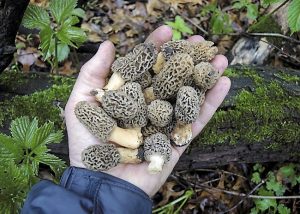
More on morels…
Beginners guide to hunting morel mushrooms.
Tips on how to train your eyes to spot morels more easily.
Morel recipes!
01/25/2017 The rusty patched bumblebee has been declared endangered in the United States
By: Sam Mejia
 Rusty patched bumblebee. (Photo: Dan Mullen/Flickr)
Rusty patched bumblebee. (Photo: Dan Mullen/Flickr)
This species of bumblebee is now endangered. On January 24th, 2017, the U.S. Fish and Wildlife Service announced that Bombus affinis has decreased significantly by 87 percent since the 1990s, with its range now limited to only 13 states.
There is a worldwide decline of bumblebees, which threatens not only our food supply, but our biodiversity as well. “A major reason bees and pollinators are in decline is urban development. With bumblebees, its not just the food they eat, but wildflowers and the whole ecosystem itself” says Clint Perry, a cognitive neuroethologist at Queen Mary University who has been studying bee cognition.
Several factors, including: intensive farming, disease, pesticides, climate-related changes, and habitat loss, have negatively influenced the number of rusty patched bumblebees over the past 50 years. The U.S. Fish and Wildlife service have been implementing programs to protect and restore these pollinators to their habitats, including recovering endangered and threatened pollinators and pollinator-dependent plants. There are many restoration groups, partnerships, and conservation efforts to support bee-friendly improvements to our local surroundings.
Bumblebees were one of the top pollinators of crops and wildflowers, including apples, tomatoes, cranberries, and peppers, in 28 states. There were several Hawaiian yellow-faced bees who were added to the Endangered Species List last year. Three more species, Franklin’s bumblebee; the western bumblebee; the yellow-banded bumblebee, are on the verge on being added to that list.
Things you can do to help include: planting more flowers, especially native species, and minimize your use of chemical pesticides and herbicides. Stay on trails when you are in the woods, there are a lot of ground nesting bees.
We do not have any rusty patched bumblebees in our collection, but we do have several other species of bumblebees! Come take a look at what we have.
References
Little, Becky. “First Bumblebee Declared Endangered in U.S.” National Geographic. National Geographic Society, 10 Jan. 2017. Web.
The Xerces Society. “The Xerces Society » Bumble Bee Conservation.” The Xerces Society » Bumble Bee Conservation. N.p., n.d. Web.
U.S. Service. Fish and Wildlife. “Fact Sheet.” USFWS: Rusty Patched Bumble Bee Fact Sheet. N.p., n.d. Web.
https://www.fws.gov/midwest/endangered/insects/rpbb/factsheetrpbb.html
01/10/2017 Welcome back Greeners!
By: Sam Mejia
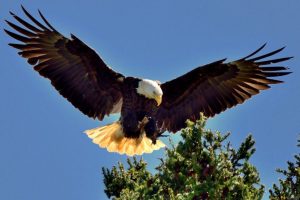
Welcome back to a very cold Winter 2017. January 10th is observed annually as Save the Eagles Day! There are more than 70 different species of eagles throughout the world. There are several species of eagles that are on the endangered list. Due to conservation efforts, the Bald Eagle was removed from the endangered list in June 2007, and there are now 5000 known nesting pairs. In 1782, the bald eagle was chosen as a national symbolic symbol.
Eagle is a common name for many large birds of prey from the family Accipitridae. Most eagles are larger than any other raptor, besides some vultures. Eagles’ eyes are impressive and have up to 3.6 times human acuity, which allows them to spot potential prey from a far distance.
In Downtown Olympia from January 20th – January 26th, The Capitol Theater will be showing “The Eagle Huntress“; this film follows a 13-year-old girl named Aisholpan as she trains to become the first female in twelve generations of her Kazakh family to become an eagle hunter. The ability to hunt with eagles is a tradition that has been handed down from father to son for centuries for these Mongolian people. Many old Kazakh eagle hunters reject the idea of a female taking part in their ancient tradition; however, Aisholpan’s father Nurgaiv believes that a girl can do anything a boy can, as long as she is determined to do so.
SCREENING TIMES:
1/20 9pm; 1/21 4pm & 6:30pm; 1/22 5pm; 1/24 6:30pm & 9pm; 1/25 4pm & 6:30pm; 1/26 4pm, 6:30pm & 9pm
Tickets available at box office 30 minutes prior to showtime.
Use #SaveTheEaglesDay to post on social media.
More articles regarding the importance of protecting eagles:
Eagles Are Worth Fighting for Today
We Must Protect Eagles and Expand Wind Power at the Same Time
This Moment Could Have Easily Never Happened
Windfarms kill 10-20 times more than previously thought
11/29/2016 Tomorrow is Remembrance Day for Lost Species
By: Allan Davis
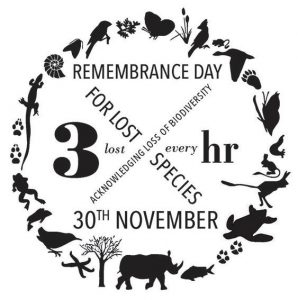
November 30th is Remembrance Day for Lost Species. It is a day to recognize the species, of both animals and plants, that have been lost in the Sixth Great Extinction event, and look at the ways in which we, as humans, are responsible for these extinctions. As anyone who is familiar with the concepts of ecology knows, extinctions are a natural event, but what makes this large-scale extinction even unique, is that human activity is the sole cause for it. Please take a moment today to think about what has been lost, and what may be lost in the future. As far as we currently know, the planet Earth is the only celestial body capable of sustaining life, and the amazing creative impulse, that takes form in biodiversity, is surely worth saving.
11/9/2016 Omnia Extares! Let it all hang out!
By: Sam Mejia

The world’s largest burrowing clam the geoduck (pronounced gooey-duck), Panopea generosa, lives in the subtidal waters of the Puget Sound. The word is derived from the Lushootseed word gʷídəq, meaning “dig deep”. This Pacific geoduck is native to the Pacific Northwest and is one of the longest-living animals with a lifespan of up to 145 years; the longest on record was 168 years old. Adult geoducks have a few natural predators, including sea otters and dogfish in Alaska. Similar species have been seen to grow from Japan and New Zealand to Argentina, but the Pacific Northwest is still home to the largest geoducks.
The geoduck has two parts: a long leathery neck called a siphon that pokes out of the shell, and the thick body protected inside the shell; they typically weigh around 2 ½-3 pounds. Although, some have been weighed in at 14 pounds. The shell can grow up to 4-6 inches while the siphons are exceptionally lengthy, making the clam up to 3-4 feet. This magnificent clam uses a tiny foot to dig into the seafloor as it grows, ending up several feet under the ground and live a sedentary life. Their large siphons are used to pull phytoplankton down one side of their neck, and eject filtered water out of the other.
High market value of the geoduck has created a thriving $80-million industry in the US with harvesting farms in Oregon, Washington, British Columbia, and Alaska selling around four million pounds each year. On average, one geoduck can cost you around $20-30. Geoducks are popular in many Asian countries and are even considered a delicacy in China with reported prices ranging from $60 each to $300 at high-end seafood restaurants. They can be served raw, turned into a pie, pounded into geoduck fritters, added to ceviche, prepared in chowder, and many other delicious ways.
Speedy the geoduck, our beloved mascot, is just one of two non-insect invertebrate college mascots; the other mascot is Sammy the Banana Slug from the University of California in Santa Cruz.


(Speedy from TESC on the left & Sammy from UCSC on the right)
Our museum collection has a geoduck shell, but not a single geoduck in our wet specimen collection. On Wednesday, November 16th, Erik Thuesen guided several staff from the Evergreen Natural History Museum through wet specimen preservation, and preserved a few geoducks for our collection thanks to Taylor Shellfish Farms, the largest shellfish farm in the country. This is a great contribution due to expanding the biodiversity in our collection, and being able to use it for future research. Come by during future Wednesday open hours to take a look at our specimen!
Did you know that our school has a fight song?
Go, Geoduck go,
Through the mud and the sand, let’s go.
Siphon high, squirt it out, swivel all about, let it all hang out.
Go, Geoducks go,
Stretch your necks when the tide is low
Siphon high, squirt it out, swivel all about, let it all hang out.
References
Morgan, James. “The ‘phallic’ Clam America Sells to China.” BBC News. BBC, 19 July 2015. Web. 09 Nov. 2016.
Nosowitz, Dan. “How Do You Farm A Clam That Can Grow 3 Feet Long And Live For Over A Century? – Modern Farmer.” Modern Farmer. N.p., 26 Sept. 2014. Web. 09 Nov. 2016.
The Evergreen State College. “It’s Speedy the Geoduck.” Home. The Evergreen State College, Unknown date. Web. 09 Nov. 2016.
Tran, Lina. “Everything You Need to Know About Geoducks.” Eater. N.p., 17 July 2016. Web. 09 Nov. 2016.
WDFD. “Geoduck Clams Identification & Information | Washington Department of Fish and Wildlife.” WDFD. Washington Department of Fish and Wildlife. Unknown Date. Web. 09 Nov. 2016.
Welch, Craig. “Geoducks: Happy as Clams.” Smithsonian Magazine. Smithsonian, March 2009. Web. 09 Nov. 2016.
10/11/16 The beginning of a new year at the natural history museum!
By: Allan Davis
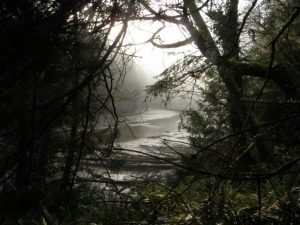
Autumn, the year’s last, loveliest smile.
-William Cullen Bryant
Hello from The Evergreen State College Natural History Museum! Welcome to a new year at Evergreen. As the year gets underway don’t forget to come by and see us in the museum. Open hours are Wednesdays from 1 pm to 5 pm or by appointment.
The fall is an exciting time in the Pacific Northwest and here in Olympia we are lucky to have many spots to witness the changing of the seasons. On campus we are surrounded by more than 1,000 acres of trail filled forest where you can watch the leaves of the big leaf maples (Acer macrophyllum) and red alders (Alnus rubra) as they change in preparation for the winter. Or closer to downtown, Priest Point Park offers 314 acres of wooded trails for your exploration. Priest Point park is located at 2600 East Bay Drive.
If you are in the mood for birding, the Billy Frank Jr. Nisqually National Wildlife Refuge will soon be inundated with returning waterfowl, such as Canada geese (Branta canadensis), cackling geese (Branta hutchinsii), gadwall (Anas strepera), American wigeon (Anas americana), mallards (Anas platyrhynchos), northern shoveler (Anas clypeata), northern pintail (Anas acuta), bufflehead (Bucephala albeola) and ring-necked ducks (Aythya collaris). For more information on the Billy Frank Jr. Nisqually National Wildlife Refuge go here: https://www.fws.gov/refuge/billy_frank_jr_nisqually/. For a comprehensive list of bird species present by month go here: https://www.fws.gov/uploadedFiles/Region_1/NWRS/Zone_2/Nisqually_Complex/Nisqually/Documents/trifold%20checklist%281%29.pdf. The Billy Frank Jr. Nisqually National Wildlife Refuge is open during daylight hours and is located at 100 Brown Farm Rd. NE.
The Kennedy Creek Salmon Trail offers a great chance to catch chum salmon (Oncorhynchus keta) as they return to their natal stream to spawn and court. The 1/2 mile trail at Kennedy Creek is open every weekend in November from 10 am to 4 pm and there are plenty of docents and interpretive signs to answer any questions you may have about the life cycle of salmon. For directions and more information on The Kennedy Creek Salmon Trail click here.
Here at the museum we have 1,900 bird specimens for viewing and you will find many examples of the birds who are returning this fall and winter. Come to the museum and get a jump on your bird identification skills before heading out into the field. We also have many wet specimens of salmon for your viewing pleasure! Here’s to a productive new academic year and the wonder of the changing seasons!